As we await Super Bowl Sunday…
What do the Beatles and Campy Campaneris have in common? Charlie Finley used each as a draw to Municipal Stadium at 22nd and Brooklyn. The Beatles on their North American tour in 1964 and Campy playing all nine positions in 1965. Who was the better draw? You will soon know.
But first, some housekeeping and short takes.
Unsubscribe: I don’t have one of those easy clicks for unsubscribing. So this is a reminder that you can reply to any post and just say “unsubscribe.” Since Hot Stove started during the euphoric times of the 2015 World Series, I realize that interest may have waned. Or my posts got too long. Or ended up with topics not matching your interest. Not enough Springsteen. Too much Little Richard. Not enough Clemente (that would be Tim Sear). There has been some evolution of the posts. So don’t be shy if you are looking for less in your inbox.
Library Event Next Week – Baseball Stadiums (Downtown?): I read a book earlier this year by Paul Goldberger titled Ballpark: Baseball and the American City. The author is an architect, and he utilizes that expertise to tell the story of baseball stadiums, both as to their design and to their placement in the city. He also weaves in stories about teams, owners and players from the days of Wrigley and Fenway through the years of multi-purpose “concrete donut” stadiums, Camden Yards and today’s newest parks. The book is beautifully illustrated.
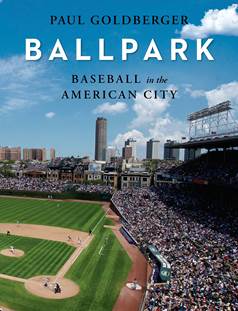
Goldberger’s book is very timely for Kansas City fans. With the change in ownership of the Royals, there has been a lot of talk about the possibility that the next Kauffman Stadium might be located downtown. We are a long way from any decision, but I’m pretty sure Goldberger would support that idea. He will be at the Plaza Library next week on Thursday night. The event is free, but requires an RSVP (click here for the details). The format will be a conversation with local author Whitney Terrell who has written an extensive review of the book (click here).
Houston’s Continuing Problems: The Astros of 2019 have had a post-season to rival the Black Sox of 1919. They fired one executive after he taunted female reporters during the 2019 ALCS celebration. They then dropped the 2019 World Series, losing all four of their home games. Last week, they fired their GM and manager for their roles in the sign stealing scandal that included their World Series victory of 2017 (but no sign stealing in the 2019 Series, possibly contributing to their four home losses to the Nationals). One pundit on Twitter had this take on a revised logo for the World Series champions of 2017:
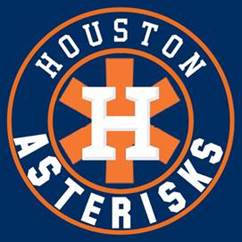
Hall of Fame: Earlier this week, sportswriters added two new names to the Hall of Fame. One was always a sure thing – Derek Jeter in his first year on the ballot. He got votes from 396 of the 397 casting ballots. The other inductee is slugger Larry Walker who was on the ballot for the 10th year, his final year of eligibility from voting by the writers. Walker got 304 votes for 76.6%, putting him just over the required 75%. The next three in the vote count are all in their 8th year on the ballot: Curt Schilling (70%), Roger Clemens (61%) and Barry Bonds (60.7%). Those three clearly have the stats for induction, but many voters are resistant because of controversial statements (Schilling) and steroids (Clemens and Bonds).
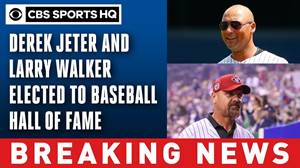
Larry Walker had a good line on his being paired with Jeter for induction: “Remember those old 45s that we used to listen to (on the record player) and they had the song on the A side, and then the song on the B side that you really didn’t know about? I’m the B side!”
Joe Posnanski’s countdown of the Top 100 players started in December and will continue until opening day (as of today, Joe is down to #63). The new Hall of Famers already have their spot on his list, Walker at #96 and Jeter at #79. For each pick, Joe writes an entertaining essay (available behind the paywall at The Athletic; click these links for Jeter and Walker).
Bill Shapiro – Cyprus Avenue: Kansas City has lost one of its best. Lawyer/deejay Bill Shapiro died this week. Bill’s day job was being a tax lawyer, but most Kansas Citians knew his name (and voice) from his weekly public radio show Cyprus Avenue. For 40 years, he told us engaging stories about pop music, especially rock ‘n’ roll. He was also a big baseball fan and a long-time Royals season ticket holder. When Bill retired from his show in 2018, I wrote a Hot Stove tribute to him (click this link). Peace to you Bill.

Warm Weather News: Rita and I had perfect weather in Cabo this past week. For those seeking warm weather in February and March, Royals pitchers and catchers report ten days after the Super Bowl (that would be February 12) . First Royals spring training game is February 21 at Surprise Stadium.
Okay, now for Finley, Campy and the Beatles.
Birmingham – The Rest of the Story: The last Hot Stove post featured the 1964 Birmingham Barons, the first integrated professional team in Alabama. The team’s major league affiliation was with the Kansas City A’s, which was owned by Birmingham native Charlie Finley. Manager Haywood Sullivan led the team to a second place finish (while the parent KC A’s went 57-105). Some of the players starring for the team were Bert “Campy” Campaneris, Paul Lindblad, John “Blue Moon” Odom and Tommie Reynolds.
In 1965, Birmingham continued to be a feeder for the A’s. In 1966, the team moved to Mobile and changed the team name to the A’s. They then returned to Birmingham in 1967, staying until 1975, keeping the A’s name rather than reverting to the Barons.
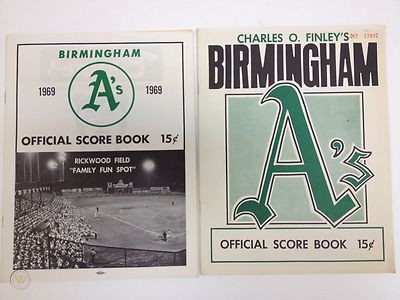
Goin’ To Kansas City (and Oakland): From Birmingham to the show.
1965 Kansas City A’s. In 1965, Haywood Sullivan became the manager of the A’s AAA affiliate which had moved from Dallas to Vancouver. But his stay in Canada was short because he was moved up to Kansas City after the A’s lost 21 of their first 26 games. At 34, he became the youngest manager in the majors. He was reunited with Campy Campaneris and Tommie Reynolds who were now starters for the A’s. Blue Moon Odom and Paul Lindblad made token appearances and moved up to the A’s for good the following season.
Finley was desperate to bring in fans for his losing team. One of his most successful promotions was on September 8 – Campy Campaneris became the first major leaguer to play all nine positions. In the 9th, playing catcher as his final position, Campy was injured tagging a runner at the plate for the third out. He missed several games because of the injury. At least two Hot Stove readers were in the crowd of 21,576 that night. One was my law partner Jeb Bayer, then a fifth-grader at Porter Elementary. The other was nine-year old Tom Turner who is today the inspirational leader of the wonderful Bishop Sullivan Center, which since 1972 has provided food, jobs and other aid to those with financial hardships.

Later in September, Finley again drew a good crowd by starting Satchel Paige, then 59(?) years old. Satch was well known in KC from his Monarchs days, and there was also the Birmingham connection (pitched for the Black Barons from 1927 to 1930). Satch previously pitched in the majors for the Indians and Browns. In his cameo for the A’s, he pitched three scoreless innings. Below, a photo from that night with Satch showing his grip to A’s pitchers Blue Moon Odom, Catfish Hunter, Dick Joyce and Ron Tompkins.
In the photo, note the signboard at the left for the A’s Zoo, the “only” one in the major leagues. The zoo had monkeys, pheasants, rabbits, a dog and two peafowl. Sheep grazed the hill behind the right field fence. The most famous of the Finley animals was Charlie O, the mule who also accompanied the team on road trips. And a mechanical rabbit that popped up behind home plate to deliver new baseballs to the umpire.
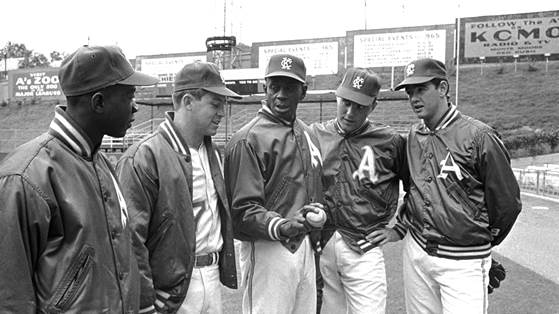
The team never recovered from its poor start and finished in last place (59-103). A ray of hope for the future was that Campy led the league in steals and triples. Two future Hall of Famers played – Catfish Hunter in his first major league season, Satchel Paige in his last. After the season, Sullivan moved to a front office job with the Red Sox and never managed again. He became part owner of the Sox after Tom Yawkey died.
1966 Kansas City A’s. More players from the Southern League A’s played at least part of the season in KC. Future all-star third baseman Sal Bando. Jim Nash who was 10-1 in 1966 and second in rookie-of-the-year voting. Kansas City native Chuck Dobson who had played in 1965 for Birmingham and Lewiston in the A’s farm system.
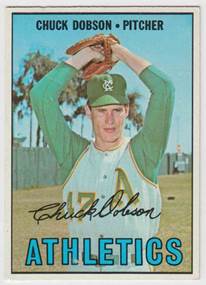
The A’s started the season on the road and lost all five games. When they returned to KC for the home opener, Chuck Dobson started the game and made history. He was the first starting pitcher to make his big league debut in a home opener in the state where he was born. And he won. The A’s were on a roll. Not a lot, but they did finish 74-86, a big improvement over 1965.
[Chuck Dobson Trivia: In 1962, Chuck was a fellow all-star with A’s teammate Paul Lindblad when the two played in the amateur Ban Johnson League in KC. He won at least 10 games a year for the A’s from 1966 to 1971, but elbow problems thwarted several comeback attempts.
1967 Kansas City A’s. The big story for the A’s in 1967 was not in Kansas City where the team lost 99 games and returned to last place. The action was in Birmingham where Charlie Finley continued to assign some of his best prospects.
Charlie wanted to give his hometown a good team, but he was also following a trend of pooling future stars at the AA level rather than splitting them up with some at AAA. In his classic Baseball Historical Abstract, Bill James said teams were doing this in the 1960s so that the players would learn to play together and establish a winning atmosphere. The AA team James used to make the point was the 1967 Birmingham A’s where manager John McNamara had future A’s stars Reggie Jackson, Rollie Fingers, Joe Rudi and Dave Duncan.
Reggie was the only black player on the team in a city that still followed Jim Crow in spite of the Civil Rights Act of 1964. He had not wanted to report to Birmingham and only did so after a personal appeal from Finley. Reggie had never been in the Deep South before and was well aware of the history of “Bombingham.” In his autobiography, Reggie says he felt lost in the city, not knowing where he could live or eat. He slept on the couch at teammates’ apartments which drew the ire of landlords. He was finally able to find a room and take the pressure off of his teammates. On the road, it was even tougher, although John McNamara sought out hotels and restaurants that would accommodate ALL of his players. If a restaurant would only give Reggie take-out, the whole team dined on take-out.
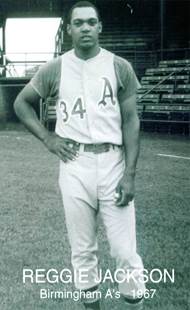
Remarkably, Reggie played like Hank Aaron had in Jacksonville in 1953. He led the A’s to the Southern League title. The team also beat the Texas League champs in the Dixie Series. Kansas City fans got a glimpse of the future when Jackson, Rudi and Duncan were called up to KC late in the season. Campy, Blue Moon, Lindblad, Catfish and Bando were already there. Future Hall of Famer Rollie Fingers was working his way through the minors.
Since the A’s had arrived in Kansas City in 1955, the team had never had a winning season. The KC and Birmingham rosters now had the players that could change that.
Then Charlie Finley moved his A’s to Oakland.
1968-1974 Oakland A’s. I’ll tell just a short story about the next seven years. All were winning seasons. Birmingham continued to produce. Vida Blue. Gene Tenace. Dave Hamilton. Beginning with Campy, Blue Moon and Paul Lindblad in 1964, the Birmingham veterans formed the nucleus of a dynasty. The Oakland A’s won the World Series three years in a row. 1972. 1973. 1974. This has only been done once since then – the 1998-2000 Yankees.
Below, Charlie with his three World Series trophies. He also had full-sized copies made for select front office members and players, and one of those ended up in the hands of a Finley friend in Kansas City, Jim Chappell. Jim’s trophy is from 1973 and you can see it behind the bar at Chappell’s Restaurant & Sports Museum in North Kansas City.
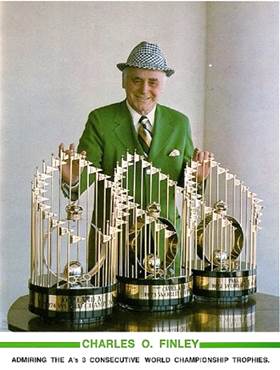
Charles O. Finley – Baseball Talent Scout: Fans in Kansas City and Oakland assuredly have different perspectives on Charlie Finley. The move to Oakland after the 1967 season was no surprise. Charlie had threatened to move to various cities over the years. So KC fans and the local press had no reason to appreciate something good about Finley – he was an excellent baseball talent scout.
I offer as proof the opinion of Marvin Miller who became the leader of the players’ union in 1966. In Miller’s autobiography, A Whole Different Ball Game, he flatly says that Finley “was, without a doubt, the finest judge of baseball talent I ever saw at the head of a team.” Miller was impressed by how well Finley filtered a parade of good ballplayers through Birmingham. “For most of the years that Finley ran the A’s, he was the team’s chief talent scout. In fact, during some of the leaner years he was the team’s only scout.”
Charlie did well signing amateurs before there was a draft (e.g., Catfish and Blue Moon in 1964, giving each of them a $75,000 bonus). He also was successful after the draft was instituted in 1965 (Reggie, #2 pick in 1966). But Miller found that Charlie’s stubbornness could lead to losing talent – the best example being the loss of Catfish Hunter to the Yankees after Catfish became a free agent because Charlie failed to make promised annuity payments. Soon after the A’s World Series years (1972-74), the union won the fight over the reserve clause. This led to a collective bargaining agreement with arbitration and free agency. Charlie did not adjust well to the new rules.
As Miller colorfully summarizes…
“Finley did the jobs of four men – unfortunately, three of them were named Groucho, Chico and Harpo. It was as a talent scout the he helped his team the most, but in the age of free agency he didn’t know how to hold on to the talent he discovered. Probably it wasn’t in his nature to compete for a player after he brought him up through the system and regarded him as “his.” No one made better use of the amateur free-agent draft that went into effect in 1965. It was designed to help second-division teams improve if they had an eye for baseball talent. Finley had it…He never really understood salary arbitration…He argued his own arbitration cases (Poorly, I should add)…Still, though I’m almost ashamed to admit it, I was charmed by the man.”
Below, from 1974 in Sports Illustrated, Finley with (clockwise from top L-R) Rollie Fingers, Joe Rudi, Vida Blue, Gene Tenace, Campy Campaneris, Catfish Hunter, Sal Bando and Reggie Jackson.
, Jim Catfish Hunter, Sal Bando & Reggie Jackson during a 1974 SI photo shoot. (Neil)
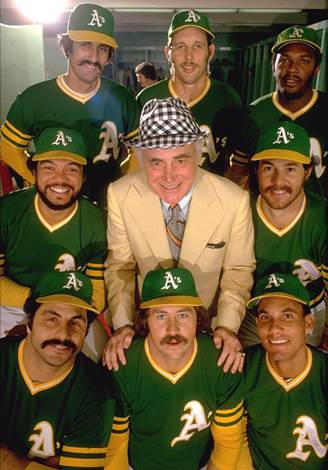
After free agency got underway, Finley lost most of his stars by 1977. He also got into fights with Commissioner Bowie Kuhn who vetoed some trades and sales of A’s players that Kuhn considered detrimental to baseball. The A’s returned to the second division. Finley still had an eye for prospects (e.g., Ricky Henderson in the 4th round of the 1976 draft). But, needing funds for a divorce settlement, he sold the team in 1980.
Lonnie’s Jukebox – Charlie and the Beatles: While the Barons were almost winning a pennant in 1964, and the A’s not (57-105), Finley jumped on the Beatles bandwagon. The 25-stop U.S./Canadian tour was taking place in August and September. Charlie wanted to add KC’s Municipal Stadium to the tour, and he kept upping up his offer until the Beatles said okay at $150,000. Some perspective – that amount was equal to the combined bonuses for Catfish and Blue Moon. The tickets ranged from $2.00 to $8.50 for the September 17 date. A photo of Charlie with a Beatles wig was on the back of each ticket.
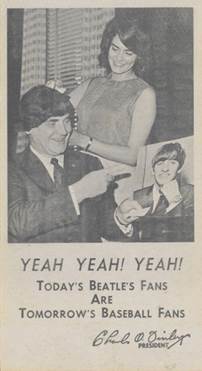
At least four Hot Stove readers were in the crowd of 20,207 that night. My wife Rita (did not know her then) and her friend Anne Devaney. Future politico friend Jan Hodgson. My pal Jay DeSimone who cut school with me in the 8th grade to attend the first A’s game in KC in 1955. Please note that Campy outdrew the Beatles the next year when he played nine positions (21,576).
The Beatles were hot. They had their first #1 record in the U.S. in early 1964 (“I Want to Hold Your Hand” topped the charts for seven weeks). They followed with five more #1 songs in 1964. Many of those songs were on the setlist for the tour, but Kansas City was the only stop that got an old favorite from their days in Hamburg: “Kansas City/Hey-Hey-Hey-Hey,” a medley that covered Wilbert Harrison’s “Kansas City” and Little Richard’s “Hey-Hey-Hey-Hey.” That would be the Little Richard from Blue Moon’s hometown of Macon. To get an approximation of how that sounded, click here to see the Beatles singing the medley a month later in a live performance on the British version of “Shindig.” One big difference. You can hear the words on the Shindig appearance. Rita confirms the newspaper reports that the screaming fans at the concert drowned out the words of all of the songs in the entire 31-minute performance.
Bill’s Jukebox – Cyprus Avenue: For 40 years (1978-2018), the best jukebox in town was the one played every Saturday by Bill Shapiro on KCUR’s Cyprus Avenue. To get a flavor, you can listen to some of Bill’s favorite records by scrolling to the playlist at the end of Hot Stove #75 (click here).
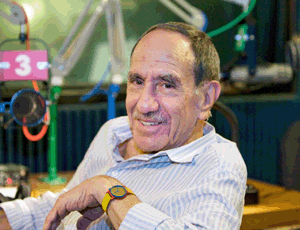
Bill opened and closed his show with an instrumental titled “Interlude.” If you were a fan of the show and listen to the opening bars of “Interlude” (click here), I’m betting you will anticipate Bill’s wonderful voice saying…
“The name of the show is Cyprus Avenue and my name is Bill Shapiro.”
As “Interlude” played at the end of the show, Bill thanked his producer and engineer and then gave his signature signoff…
“Be well everybody.”
Thank you Bill.